HP HPE6-A45 Implementing Aruba Campus Switching solutions Online Training
HP HPE6-A45 Online Training
The questions for HPE6-A45 were last updated at Mar 28,2025.
- Exam Code: HPE6-A45
- Exam Name: Implementing Aruba Campus Switching solutions
- Certification Provider: HP
- Latest update: Mar 28,2025
Refer to the exhibit.

AOS-Switches will enforce 802.1X authentication on edge ports. The company has two RADIUS servers, which are meant to provide redundancy and load sharing of requests. The exhibit shows the planned RADIUS settings to deploy to the switches.
What should customers understand about this plan?
- A . AOS switches do not support two RADIUS servers for redundancy, instead, a secondary authentication method is required.
- B . Dynamic authentication is only permitted on one of the RADIUS servers and must be removed from the other.
- C . Each RADIUS server must use a unique port number for the authentication and dynamic authorization port.
- D . Each AOS-Switch will send all RADIUS requests to the first server on the list unless that server becomes unreachable.
An administrator wants to ensure that an AOS-Switch forwards all traffic that it receives on interface 1 with high priority.
– Switches should also communicate the high priority to other switches across the traffic path.
– The switch has type of service disabled.
– The administrator plans to apply 802.1p priority 5 to interface 1.
What should the administrator check to ensure that the configuration will work properly?
- A . Interface 1 receives traffic with a tag.
- B . The AOS-Switch is configured to use eight queues.
- C . The forwarding path for the traffic uses VLAN tags.
- D . An 802.1p-to-DSCP map exists for priority 5.
Refer to the exhibit.

A network administrator sets up prioritization for an application that runs between Device 1 and Device 2.
However, the QoS for the application is not what the administrator expects.
How can the administrator check if the network infrastructure prioritizes traffic from Device 1 and Device 2?
- A . Run a packet capture on Device 2, run the application, and look in the packet capture for a high value DSCP in the IP header.
- B . Set up RMON alarms on the switches that trigger when a high number of packets are dropped. Then, run the application and check for the alarm.
- C . Clear interface statistics on the switches. Then, run the application and check the interface queue statistics for the switch-to-switch links.
- D . Run a packet capture on Device 1, run the application, and look in the packet capture for a high value DSCP in the IP header.
Refer to the exhibits.
Exhibit 1.
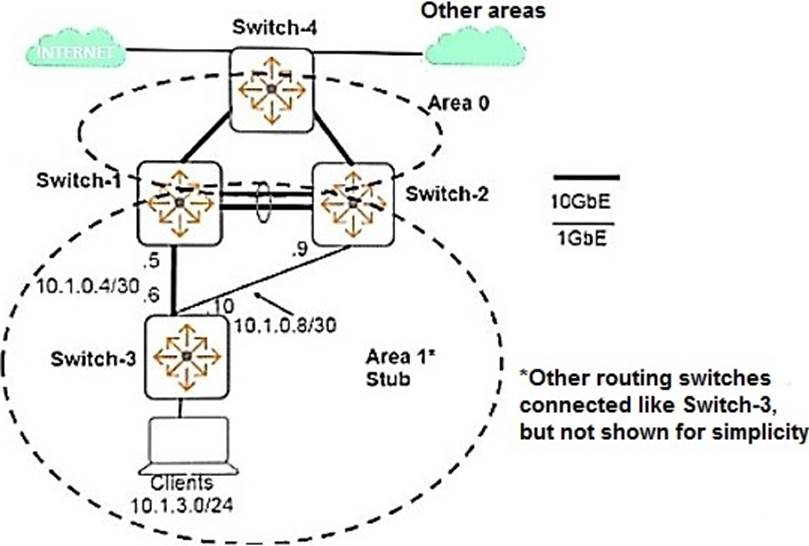
Exhibit 2.
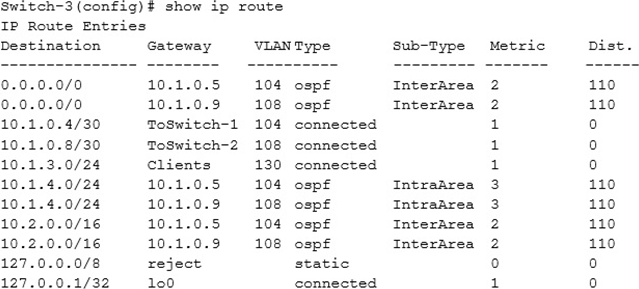
The exhibits show the current operational state for routes on Switch-3. The company wants Switch-3 to prefer the link to Switch-1 over the link to Switch-2 for all intra-area, inter-area, and external traffic.
What can the network administrator do to achieve this goal?
- A . Set the OSPF cost on VLAN 108 higher than 1 on Switch-2 and Switch-3.
- B . Set the OSPF administrative distance on Switch-2 higher than 110.
- C . Set the OSPF area type to normal on all of the switches in Area 1.
- D . Set the cost in the OSPF Area 1 stub command higher than 1 on Switch-2.
An AOS-Switch implements tunneled node.
Which benefit does the PAPI enhanced security key provide?
- A . It validates the signature for firmware pushed to the switch dynamically.
- B . It encrypts traffic sent and received by tunneled-node endpoints.
- C . It authenticates control traffic between the switch and its Mobility Controller.
- D . It provides an extra layer of authentication for endpoints on tunneled-node ports.
Refer to the exhibit.

A network administrator needs to deploy AOS-Switches that implement port-based tunneled node. Their Aruba controller has IP address 10.1.10.5/24. The architect has assigned tunneled-node endpoints to VLAN 20.
What is one issue with the current configuration planned for VLAN 20 on the switch?
- A . VLAN 20 must have GRE enabled on it.
- B . VLAN 20 cannot have an IP address.
- C . VLAN 20 must have an IP address in the same subnet as the controller.
- D . VLAN 20 must not enable jumbo frames.
OSPF Area 1 has two ABRs. One ABR is configured with this range for Area 1: 10.10.0.0/16. The other ABR is not configured with a range for Area 1.
Which type of issue occurs due to this mismatch?
- A . The ABRs create a discontinuous area and disrupt intra-area routing between devices within Area 1.
- B . The ABR core would send Area 1 traffic destined to the other switch through an access switch.
- C . The ABRs lose adjacency entirely and cannot route traffic between each other at all.
- D . The ABRs lose adjacency in Area 1 and must route all traffic to each other through Area 0.
Refer to the exhibits. Exhibit 1.
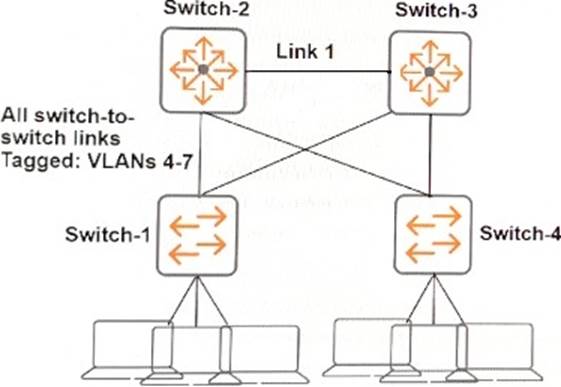
Exhibit 2.
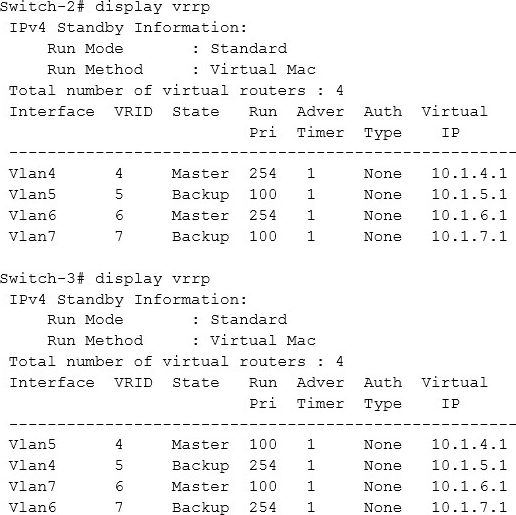
The company wants to minimize congestion on Link 1.
Which spanning tree implementation meets this goal?
- A . Instance 1 = VLANs 4-5 Instance 2 = VLANs 6-7
Switch 2 instance 1 priority = 0
Switch 2 instance 2 priority = 1
Switch 3 instance 1 priority = 1 Switch 3 instance 2 priority = 0 - B . Instance 1 = VLANs 4,6 Instance 2 = VLANs 5,7
Switch 2 instance 1 priority = 0 Switch 2 instance 2 priority = 1
Switch 3 instance 1 priority = 1 Switch 3 instance 2 priority = 0 - C . Instance 1 = VLANs 4,6 Instance 2 = VLANs 5,7
Switch 2 instance 1 priority = 0 Switch 2 instance 2 priority = 1
Switch 3 instance 1 priority = 0 Switch 3 instance 2 priority = 1 - D . Instance 1 = VLANs 4-5 Instance 2 = VLANs 6-7
Switch 2 instance 1 priority = 0 Switch 2 instance 2 priority = 1
Switch 3 instance 1 priority = 0 Switch 3 instance 2 priority = 1
Refer to the exhibit.
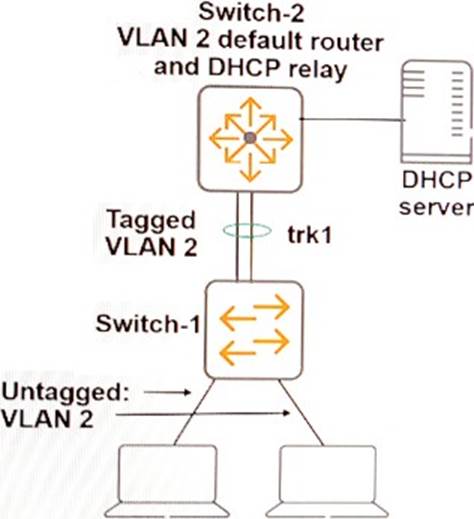
The network administrator enables DHCP snooping globally and on VLAN 2. An additional step is mandatory for DHCP snooping to operate correctly and for clients to receive DHCP settings.
What is the additional mandatory step?
- A . Define trk1 as a trusted DHCP port.
- B . Define an authorized DHCP server.
- C . Enable ARP protection.
- D . Define edge ports as untrusted DHCP ports.
Refer to the exhibit.
A network administrator configures connection rate filtering on interface 1 with the throttle action. Device 1 crosses the threshold and triggers the action.
What does the switch do?
- A . It temporarily drops all IP traffic from Device 1 only.
- B . It temporarily drops all IP traffic on interface 1.
- C . It drops all IP traffic from Device 1 until the host is manually unblocked.
- D . It drops all IP traffic on interface 1 until the interface is manually unblocked.
Latest HPE6-A45 Dumps Valid Version with 167 Q&As
Latest And Valid Q&A | Instant Download | Once Fail, Full Refund


nice experience please provide more quiz